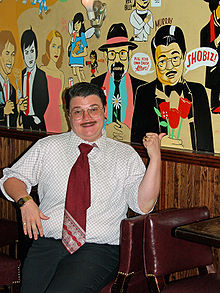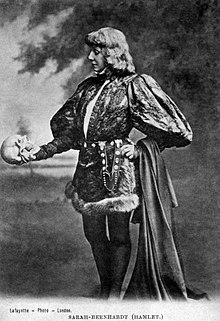Dragking
As a Drag King (based on drag queen ) a woman is referred to within a stage role in typical male attire and appearance stereotype is male behaviors or satirized. In addition, there are a number of dragkings who do not see themselves as women in a heteronormative context or are men themselves who exaggerate certain types of masculinity, for example machism . The activity of drag kings is also known as kinging . Kinging also happens partly in everyday life, partly in the protected area of a subcultural scene . The term drag comes from English and in this context means disguise or costume and refers to the wearing of clothes of the opposite sex.
history
The term dragking appears in the literature for the first time in 1972, but there is a much longer tradition of portraying male roles by women, especially in the context of a so-called trouser role . Examples are Eel the Dragoons , who died in a fight in Rotterdam in 1710, the English poet and actress Susanna Centlivre, who appeared as a man around 1700, the American Annie Hindle around 1870 and Sarah Bernhardt .
Drag kings as a phenomenon of a special cultural scene have their origins in the Anglo-American lesbian scene around the early 1990s . An early film document of such a drag-king performance is the feature film The Maiden Machine by Monika Treut , which premiered in 1988 at the Toronto International Film Festival . The film sequences shot in San Francisco contain a four-minute strip show from the one wo / man show by drag king Shelly Mars, developed during this time, as the stage character Martin in front of the audience of a lesbian scene club. Beyond the club stage and her male stage character, Mars embodies the mysterious feminine woman Ramona in the film.

Pop singer Lady Gaga played Jo Calderone at the 2011 MTV Video Music Awards in a surprising and highly acclaimed drag-king performance . Jo Calderone refused to be addressed as Lady Gaga throughout the event, causing irritation among the press and audiences in Los Angeles . According to press reports, Jo Calderone did not just leave the stage appearance, but also used the men's room backstage.
motivation
Dragkings of the various subcultural dragking scenes are mostly people socialized as women, who, however, question the gender assignment and gender role of their socialization for various reasons. The drag-king performance gives them the opportunity to explore the boundaries of bisexuality, to actively gain experience with a different design of “gender” and to make gender norms visible and questionable in a performance in front of an audience.
Some researchers differentiate between kinging and mere imitation of masculine behavior or passing through or passing as a man. In the 17th and 18th centuries, many working-class women wore men's clothes and pretended to be men in order to gain freedoms that women did not have at that time, e.g. B. women disguised as men could join the military and earn more money. Women like Jeanne d'Arc and Christina (Sweden) were often mistaken for men, but their passage as men differs from kinging because kinging is a conscious performance of masculinity in which masculine characteristics are deliberately exaggerated.
Kinging can embody men and certain types of masculinity through deliberate means when dealing with the social norm of bisexuality. The masculinity, which is widely regarded as “real”, can thus be made visible in its permanent social construction within human encounters .
Differentiation of "Dragking" - "Transgender" - "Transmann"

In practice, the concept of “dragking” cannot be clearly delineated from the concepts of “ transgender ” or “ trans man ”; transitions are fluid here. On the one hand, the social spaces of dragkings and transgender people often overlap. On the other hand, experience in the scenes shows that in some of the drag kings the desire for a renewed disambiguation of the gender identification develops, whereby hormone intake or gender reassignment operations are sometimes used as an aid.
In addition, a strict definition of this term in the sense of scientific authority is avoided in the queer-theoretical discussion of the phenomenon of "dragking". This takes into account the changeability and openness of the term and the appropriation by those who use it in the respective social spaces of the scenes for self-definition, comparable to terms such as “ queer ” or “transgender”.
Movies
- Man for a day. by Katarina Peters , 2012, 96 min, documentary about the Drag King workshop of the New York performance artist Diane Torr
- Venus Boyz by Gabriel Baur , 2001, 104 min, documentation of the international drag king scene.
Films that contain sequences with drag-king performances:
- Yes, We Are by Magda Wystub (idea / direction / editing) and Katrina Schaffer (camera), Poland / Germany 2011, 69 min, documentary about forms of resistance in the struggle for lesbian visibility and recognition in Poland.
- Gendernauts by Monika Treut, Germany 1999, 86 min, documentary about trans-gender in San Francisco.
- Die Jungfrauenmaschine / Virgin Machine by Monika Treut, Germany 1988, 84 min, feature film.
- Lady Oscar / The Roses of Versailles , first broadcast in Germany in March 1995 on RTL2, manga / animated series
literature
- Lauren Wells Hasten: Gender Pretenders: A Drag King Ethnography. Department of Anthropology, Columbia University in the City of New York. February 1999, online .
- Uta Schirmer: Shaping gender differently. Drag Kinging, gender relationships and realities. (Zugl .: Frankfurt (Main), Univ., Diss.) Transcript, Bielefeld 2010, ISBN 978-3-8376-1345-2 . Book information (PDF; 239 kB)
- Nina Schuster: Other rooms. Social practices of space production by drag kings and transgender people. (Zugl .: Marburg, Univ., Diss., 2010) Transcript , Bielefeld 2010, ISBN 978-3-8376-1545-6 .
- Pia Thilmann, Tania Witte & Ben Rewald (eds.): Drag Kings. With beard glue against patriarchy. Querverlag, Berlin 2007, ISBN 978-3-89656-142-8 . Book info
- Donna Jean Troka, Kathleen LeBesco, Jean Bobby Noble (Eds.): The Drag King Anthology. Haworth Press, New York / London / Oxford 2003, ISBN 978-1560233091 .
- Del LaGrace Volcano, Judith Halberstam : The Drag King Book. Serpent's Tail, London 1999, ISBN 978-1852426071 .
- Judith Halberstam: Drag Kings: Masculinity and Performance. (1998) In: Ken Gelder, Sarah Thornton (eds.): The Subcultures Reader. 2nd revised and updated edition, Taylor & Francis , 2005, pp. & # 160 and 400-421 ISBN 978-0415344166
- Judith Halberstam: Female masculinity. Duke University Press, 1998, pp. 160 and 231-266, ISBN 978-0822322436
- Jana Katz, Martina Kock, Sandra Ortmann, Jana Schenk, Tomka Weiss: Sissy Boyz. Queer performance. Series queer lab, Volume 3. thealit , Bremen 2011, ISBN 978-3-930924-19-6 .
Web links
Magazine / newspaper articles:
- emma.de: Sexuality and identity: Are drag kings the better seducers? ( Memento from July 12, 2010 in the Internet Archive ) Jack Halberstam in EMMA 6/1999.
- The Weekly: The Power of the Drag Kings. A lesson in patriarchy. No. 46, November 15, 1996. (PDF; 744 kB)
Videos of dragking workshops:
- an.schlag tv: drag king workshop. Vienna 2011, 16 min
- Genderfuck Workshop of the Sissy Boyz ; Ladyfest Vienna 2005, YouTube , 3 min
Videos appearances / performances:
- Performance and interview of the Sissy Boyz at the Ladyfest Vienna 05; TV report in an.schlag tv (5:28 min - 8:46 min)
Individual evidence
- ↑ a b c Nina Schuster: Other rooms. Social practices of space production by drag kings and transgender people. (Zugl .: Marburg, Univ., Diss., 2010) Transcript , Bielefeld 2010, ISBN 978-3-8376-1545-6 . P. 15
- ↑ Merriam-Webster: Drag , Section 7 a / b. Retrieved January 4, 2011
- ↑ Bruce Rodgers: The queens' vernacular: a gay lexicon. Straight Arrow Books, 1972
- ↑ Laurence Senelick: The changing room: sex, drag and theater. Routledge, 2000, ISBN 9780415159869
- ^ Mary Pix, Melinda Finberg: Eighteenth-century women dramatists. , Oxford University Press, 2001, p. XVIII, ISBN 9780192827296
- ↑ Judith Schönenberger: Visual strategies of drag kings in a media context. Theoretical diploma thesis, Zurich University of the Arts, 2008, p. 3. (PDF; 792 kB)
- ↑ Del LaGrace Volcano, Judith Halberstam : The Drag King Book. Serpent's Tail, London 1999, ISBN 978-1852426071 , p. 67.
- ↑ hyenafilms.com: THE VIRGIN MACHINE. Occupation. (accessed October 4, 2010).
- ↑ showbiz.de: Lady Gaga impressed at the 'VMAs' as Jo Calderone . August 31, 2011. Retrieved September 25, 2011.
- ↑ Maite Escudero Alías: Long Live the King: A Genealogy of performative Genders . Cambridge Scholars Publishing, Cambridge 2009, ISBN 978-1-4438-0216-1 , p. 61 .
- ^ New York Times: THEATER; Meet Downtown's New "It" Boy. January 9, 2005. Retrieved January 3, 2011.
- ↑ Nina Schuster: Other rooms. Social practices of space production by drag kings and transgender people. (Zugl .: Marburg, Univ., Diss., 2010) Transcript , Bielefeld 2010, ISBN 978-3-8376-1545-6 . P. 15f
- ↑ salzgeber.de: press kit for Man for a day. P. 2 (PDF; 587 kB) Accessed November 27, 2012.
- ^ The weekly newspaper online: Women are better men. Gabriel Baur documents the international drag king scene with “Venus Boyz”. February 28, 2002.
- ↑ Magda Wystub in the catalog of the German National Library

